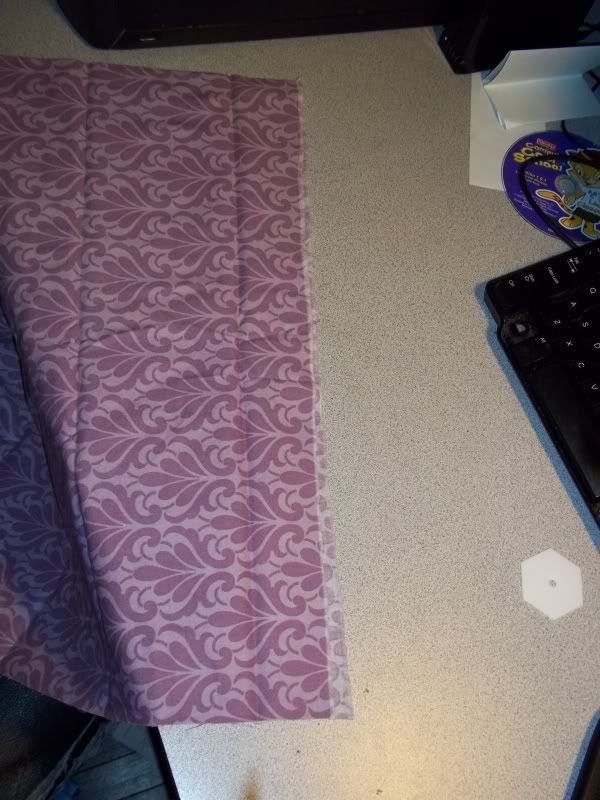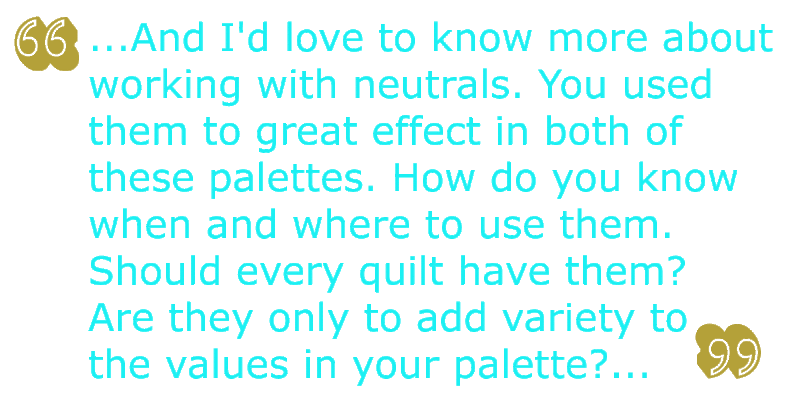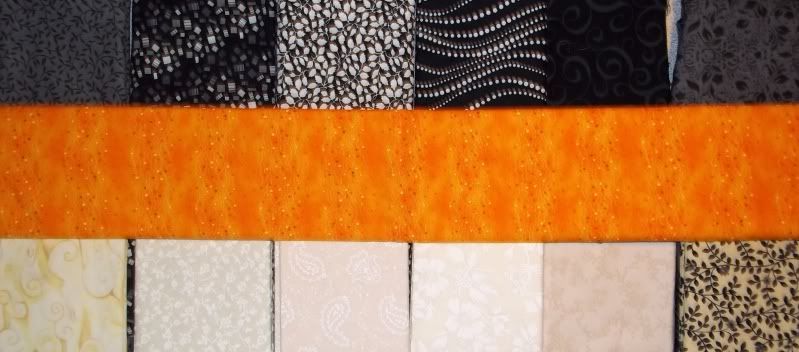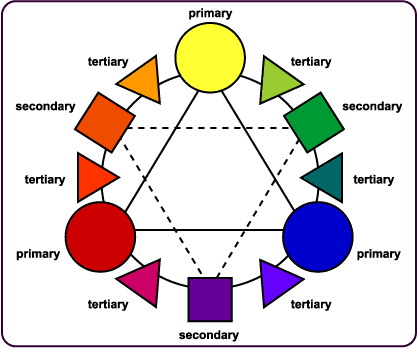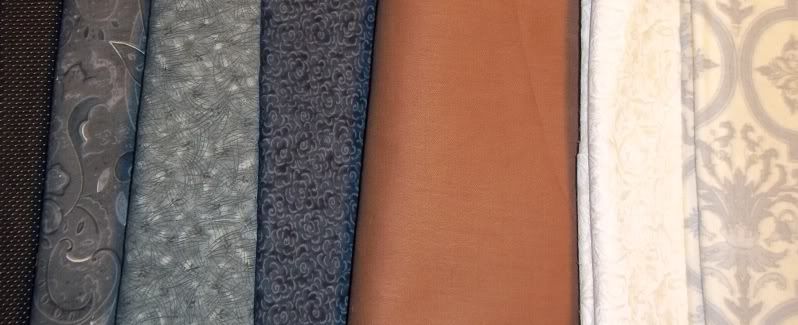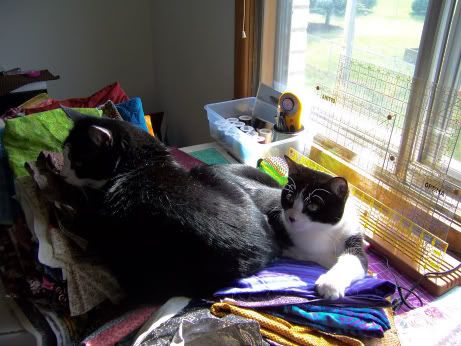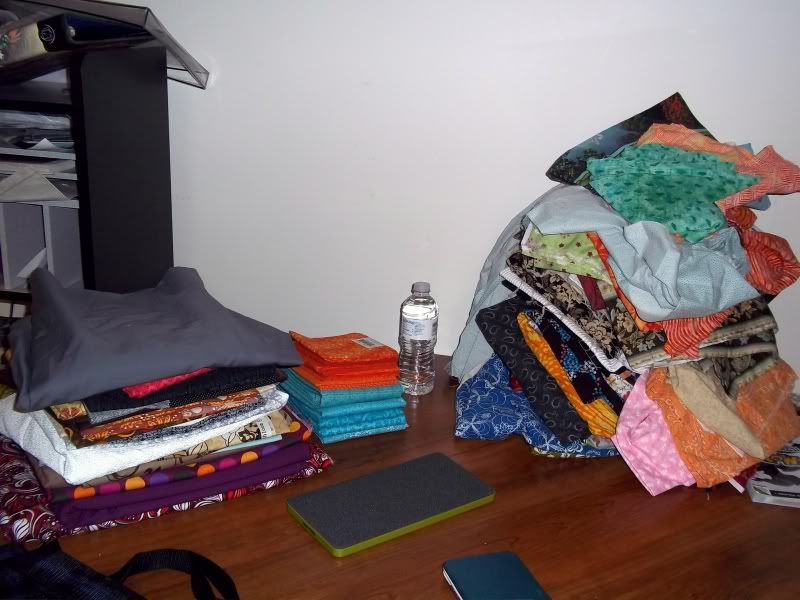...or, We Bought the Pretties. Now What Do We Do With It?!? (For Sandi's segment on Quarter Inch Seams, go here.) This is a word-heavy post. Some things there are just no photos for...
Getting to Know Your Fabric
Straight of grain runs parallel to the selvage. In the photo below, I selected a fabric with a clearly denoted selvage. Look for the finished border to your fabric, running along the length of it, with fabric that's been printed to the edge. When you pull the fabric along the straight of grain, there is very little give. Your cross grain is exactly what it sounds like and run perpendicular to the the straight of grain. You'll find that the cross grain has more give. Some folks say that you can tell the difference between cross grain and straight of grain by the sharpness of the sound when you snap the fabric. I couldn't tell you - I've never done it.
True bias runs at a 45 degree angle to your selvage or straight of grain. This is important to be aware of because bias cut fabric will have a lot of stretch. This is why bias binding is used for curves.
But, whoops! We've cut the selvage off our fabric, as in the photo below. How do we create a truly straight edge in order to avoid bias edges?
1.) Make a small cut through only one layer of fabric, perhaps an inch long:
2.) Take that little bit of fabric and RIP it. Seriously. Rip the fabric with your bare hands. It's easy. (Yeah, Zeb had to get involved when he saw a camera out).
3.) Align your newly straight edges and cut as usual.You can see some of the thread of the fabric that got pulled out. That's nothing to worry about.
To Pre-Wash Or Not?
I used to be a dedicated pre-washer. In fact, I still pre-wash. However, now I have a lot more information at my disposal. My new answer to the pre-washing debate, which actually comes up quite a bit, is "It depends".
"It depends on what?" you might ask.
First of all, am I going to simply stash the fabric question? If yes, then I am quite likely to just put it on the shelves without washing. Now, why would I do that? Because fabric straight off the bolt has been chemically treated with preservatives that are stain resistant, maintain pH balance, mitigate discoloration, prevent mold and fungi infestations, and, in general, keep our own handling of the fabrics from harming them further.
Yes, I said that our own handling of material damages fabrics. I give you Locard's Principle of Exchange, which states that 'with contact between two items, there will always be an exchange'. This principle is typically connected with forensic sciences, but those of who collect (whether we collect fabrics, yarns, buttons, or coins) need to be aware of it too. Basically, it means that no matter how minute the contact is between me and my fabric, I'm going to leave evidence of that contact.
This will typically be in the form of oil from my skin (which can be harmful all on its lonesome, carrying dirt, disease and acid), but what if I was just scrubbing my kitchen floor with bleach in the mop water before I went to work in the sewing room? No matter how well I scrub, there will still be traces of that bleach on my hands. Now, imagine that I touched my fabric. I might have just created a series of small, slowly self-bleaching spots on my fabric, if I've pre-washed, and especially if my fabric is exposed to sunlight in concentrated amounts.
If I had left my stash fabrics unwashed, that bleach might not have become a problem. The layer of preservative that I left intact would have continued to do their job and keep my fabric looking as crisp and bright as the day I bought it.
I also have a little boy who likes to play in my fabrics. He's three and thinks that dirt and mud are the best stuff on earth. I'm not always around to police his access to my fabrics. I can't tell you how many times I've found my fabric rifled through, with little hand prints all over it. Honestly, it would be less of an issue if my fabrics weren't pre-washed. They'd still have the stain-resistant coatings on them to prevent his little fingers from being little stains.
If I had left my stash fabrics unwashed, that bleach might not have become a problem. The layer of preservative that I left intact would have continued to do their job and keep my fabric looking as crisp and bright as the day I bought it.
I also have a little boy who likes to play in my fabrics. He's three and thinks that dirt and mud are the best stuff on earth. I'm not always around to police his access to my fabrics. I can't tell you how many times I've found my fabric rifled through, with little hand prints all over it. Honestly, it would be less of an issue if my fabrics weren't pre-washed. They'd still have the stain-resistant coatings on them to prevent his little fingers from being little stains.
But, now, keep in mind that I said, "It depends." A lot of people are allergic to some of the most common preservatives in the world. Do you walk into your sewing room, or wherever your stash is stashed, and find yourself sneezing, no matter how often you de-lint your sewing machine? Do you have skin irritation after handling your sewing projects? You probably ought to consider pre-washing your stash.
It's that particular circumstance that always has me washing anything that I'm going to use in a swap. I don't want to make the recipient of my gift sick, and allergies are insidious things.
On that same token, because about 75% of my stash is currently washed, if I plan on mixing newer fabrics with stashed fabric, I have to wash the newer fabrics. Pre-washed fabrics means pre-shrunk (about 2-3% size loss), and I don't want to have unsightly puckers from disparate shrink rates. What do I mean by that? Well, if my preshrunk fabric was accurately cut to 2" finished squares and experienced no further shrinkage, while the new, not pre-washed fabric shrank the average 2-3%, then I'd have some billowy sections contrasted with more taut sections.
Another instance in which I'd pre-wash is when I have concerns about color fastness. We've all heard horror stories about the quilt that went in the washer white and red and came out pink and red! I pre-wash to get rid of excess dye and dry on high heat to set the remaining color. Some people swear by color catchers. Due to my previous staunch pre-washing stance, I've never had need of them, so I can't vouch for their effectiveness.
Pressing versus Ironing, and When to Steam or Spritz?
This is another little thing that can make a huge difference. Ironing is the act of dragging our hot iron back and forth across fabric to get the wrinkles out of it. Ironing can cause distortion! We're taught to iron damp fabric, so we're steaming, spritzing or starting with damp fabric. Dragging is friction, which can cause the grain line of fabric to be moved, especially if it's damp. Ever iron a fabric that's a repeat stripe and suddenly realize that it's not a straight line anymore, but is now curving? That would be because of ironing.
Pressing is lifting your hot iron and setting on the piece of fabric or seam to be flattened, and holding it until the seam or fabric is set. You then lift the iron up and set it on the next section of seam or fabric and hold again, with some overlap with what you've already pressed. This is often done with a dry iron and dry fabric, in contrast to ironing.
Personally, I aim to press my quilting projects, and I always use a dry iron. I start by pressing the wrong side of the fabric first to set the seams, and flip, and repeat the pressing process. The only time I steam or spritz is when I'm pressing the finished block, so that I can set the seams.


